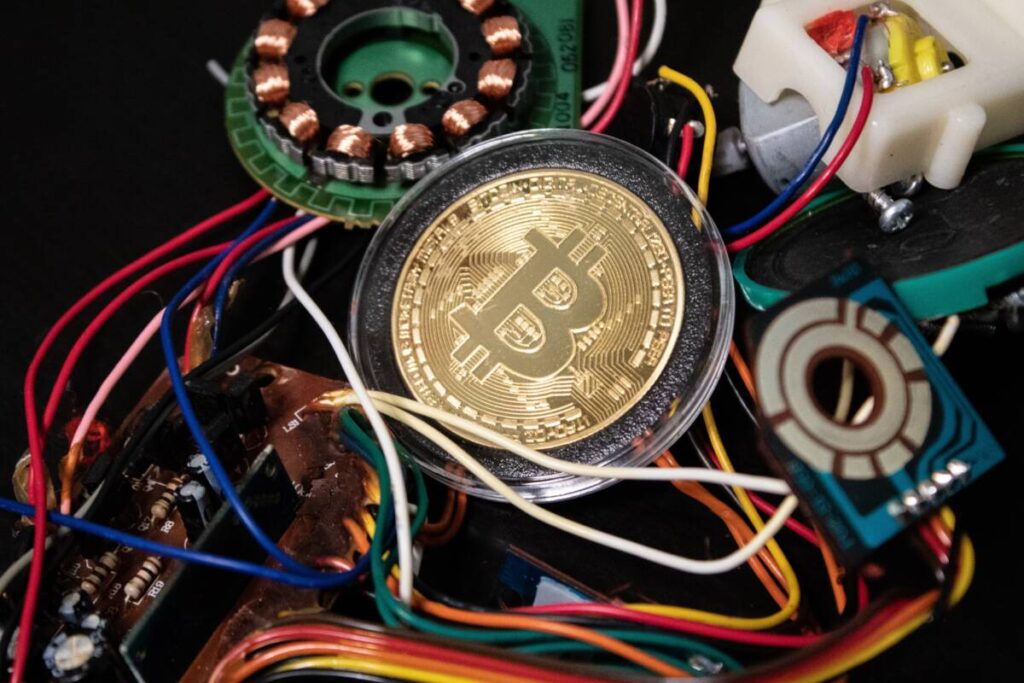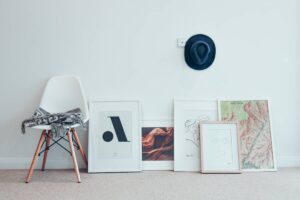NFT art has been hitting the headlines a lot, but you might be wondering what it is? And could you use it in your art business?
There is lots of potential to use NFTs to find new audiences and to explore different models for selling your work.
Let’s take a closer look…
So what is NFT art?
NFT art ‘tokenizes’ a digital artwork (or a digitized work, such as a drawing or painting). This token is a unique, permanent record of the artwork. So while digitized art is easily copied, an NFT acts like a certificate of authenticity and proves ownership. Typically, the buyer of NFT art receives a copy of the artwork (often a digital file, but may also be a physical piece) and some usage rights, together with the NFT token. It’s a way of making digitized art collectible and valuable.
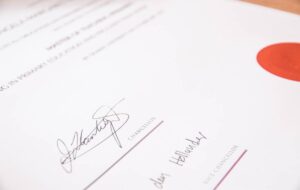
So to understand the concept in a little more detail, NFT stands for ‘Non Fungible Token’. Non fungible means that the token is unique and cannot be changed – it’s the original. In comparison, fungible means it can be swapped with other tokens of the same value, e.g. cryptocurrencies.
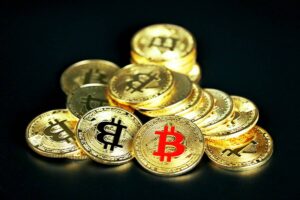
Like cryptocurrency, NFT’s run on the blockchain, which is a specialist kind of database. Information in the blockchain is organized in blocks, arranged – you guessed it – in a chain structure. Each block carries encrypted data from the previous block, and so it is not possible to modify any single block of data in the chain without modifying every block that comes after. The blockchain is then managed across a peer-to-peer network as a ‘distributed ledger’, which decentralizes the data. All this together creates a record system that is highly secure and reliable – and so it offers the art world a valuable way to prove authenticity and ownership.
Some of the stand-out examples of NFT art sales include:
- Everydays – The First 5000 days, Beeple
Probably the most widely known NFT artwork, Beeple’s ‘Everydays – The First 5000 Days’ was the first digital artwork with an accompanying NFT to sell at a major auction house. The labor-intensive collage of over 5,000 digital artworks hit the headlines for selling for a record-breaking figure – a cool $69.3million.
- Mars House, Krista Kim
Mars House is an incredible piece of art, described as ‘the first NFT digital house in the world’ by NFT art gallery SuperRare.
But don’t let this domestic description fool you – Mars House is out of this world. The Mars House is intended to be a well-being sanctuary on the red planet, and the 3D rendered glass construction is a thing of beauty. The NFT came with the rights to a copy of the house in the Metaverse, to project it onto LED screens, and also the opportunity to have real-life reproductions made in an Italian glass furniture studio.
- Gunky’s Uprising, Slimesunday
You might know Slimesunday from his massively popular Instagram account, but did you know that the collage artist has also sold over 6,000 pieces of NFT art? Gunky’s Uprising is a collaboration with the electronic music producer and NFT artist 3LAU. It is his highest value piece to date and sold for over $1.3million.
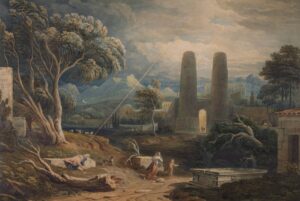
- Obey Ideal Power Mural, Shepard Fairey
Fairey used sold this work in a collaboration between Verisart and SuperRare. Fairey is a well-established artist, and probably best known for his ‘Hope’ portrait of Barack Obama. This was his first NFT sale and used Verisart’s Fair Trade Art initiative to donate the proceeds from his first NFT sale to Amnesty International.
- Bitcoin Angel, Trevor Jones
Trevor Jones is a painter who incorporates digital elements, such as AR or social media integration.
Bitcoin Angel is an oil-painted, classically inspired image, which became one of the best-selling NFT’s when he sold it as an open edition, selling over 4,000 editions for $777 in a mere 7-minute long sale. NFTs sell at a wide range of prices, so it’s a good market to test your pricing strategies with.
… and yes, you can sell editions of your work as NFT’s! Which brings us to…
How do I make my own NFT art?
NFTs are registered, or ‘minted’ on a blockchain, then typically sold through a marketplace.
To mint your own NFT’s, you will need to set up a blockchain wallet, add some currency, then mint your NFT art.
It’s pretty straightforward to mint an NFT, you generally just need to upload your file and add your descriptions.
However, there are a few things to consider before you dive right in.
It’s worth taking a moment to think about which marketplaces you might want to use to sell your NFT’s. Many marketplaces offer the option to mint your NFT’s for you, but some will only accept NFT’s that you have minted with particular blockchains. A good blockchain to take a look at is Eretheum, which is widely used for minting art NFT’s.
Marketplaces for NFT art include OpenSea, Nifty Gateway, and SuperRare. These last two are art-specific and require you to go through a registration process to join as an artist.

So, let’s take OpenSea as a great example. With OpenSea, it’s free to register and sell your NFT’s, although there are some account initialization costs. OpenSea then charges their fees when your NFT sells.
Like many NFT art marketplaces, OpenSea uses Ether, a cryptocurrency from the Eretheum blockchain.
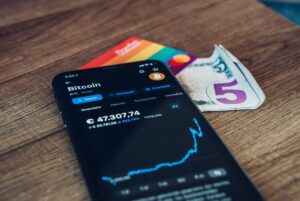
The first step is then to set up a cryptocurrency account, such as Coinbase, and buy some Ether (ETH). You then need to set up a wallet, such as Metamask, which will hold your Ether. Your wallet is important because it also manages your transactions between the blockchain and your marketplace.
Next, signup to OpenSea, and then connect your wallet to this new account. You can then set up your collection, which is like a gallery or a store.
Then, you can add a new item – which is where you mint your NFT. Upload your file, add your descriptions, and hit publish.
See, simple!
Take your time to explore the item and collection options. You can personalize your collection page with a banner image, as well as setting your payment preferences. A great feature of NFT art is that when it sells on the secondary market, you can get a cut of the price increase, and you can decide on this level of commission.
If you want to put your NFT up for sale you then need to post a listing. There is an initialization fee for this, but you only pay it once.
Building your product
So now you know how to mint NFTs, take a bit of time to think about how you will create the most valuable product for your customer.
Of course, the most expensive NFTs are unique editions (1/1). These often come with extra products or rights for the buyer, such as the original painting, an exclusive download, or perhaps a video chat. Trevor Jones even sells NFTs accompanied by his artist’s palettes.
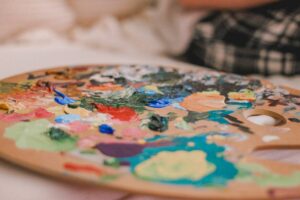
But it’s possible to sell larger editions, too, which can be open or limited. This gives you the opportunity to test your price points, and to try building different bundles to suit different audiences.
It’s a little fiddly to add editions on OpenSea, so check out the detailed guide here.
Other considerations
So this all seems pretty great, huh? NFTs offer a new marketplace for your artwork that is accessible and has high levels of trading.
But is there anything else to keep in mind?
As with any emerging trends, there are some aspects of NFTs that you might want to consider…
- Environmental concerns. The blockchain is hungry. It’s estimated that Erethium uses about the same amount of energy as Oman. Whilst more energy-efficient models are being developed, the environmental concerns are enough to slow down some artists’ adoption of NFT. Take a look at Palm for a sustainable option.
- Ownership / intellectual property issues. NFTs work as a collectible, valuable version of your art, but they do not stop your images from being copied. And it’s possible for people to mint an NFT for a work that they don’t actually own, although many specialist art marketplaces invest in making sure their pieces are authentic. There are lots of legal issues around NFTs that are yet to become clear, so make sure to keep an eye on any emerging court cases and if in doubt, seek professional advice.
Conclusion
NFT art is an exciting new way to sell your work, and has an audience that is eager to buy.
And as costs can be low, it’s a great marketplace to try and there’s lots of opportunity to experiment.
Let us know how you get on in the comments.

